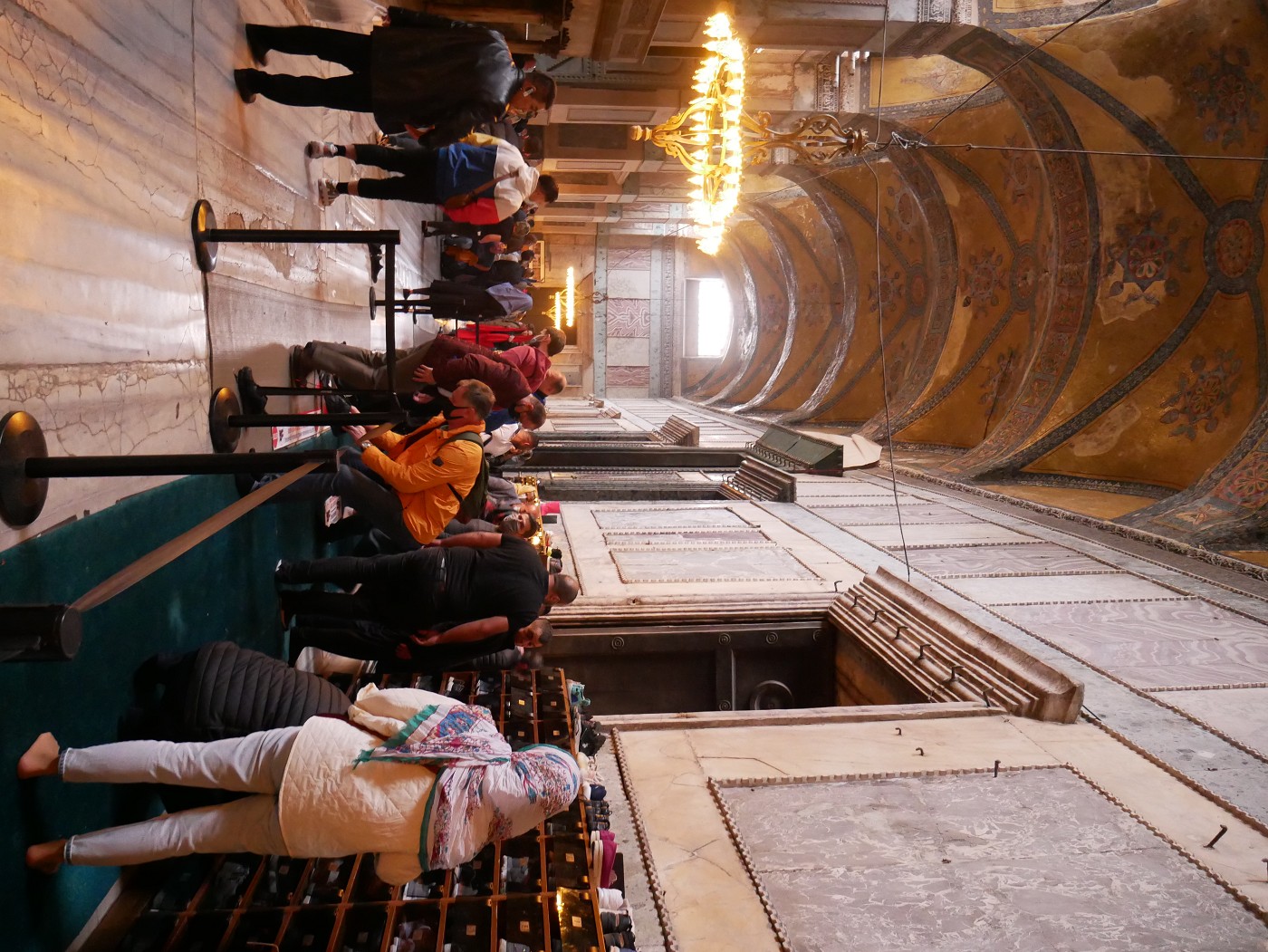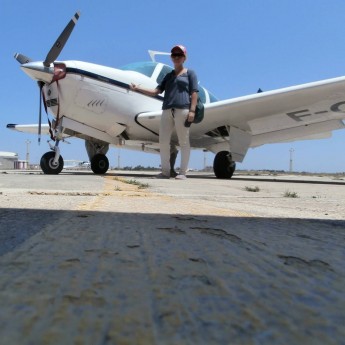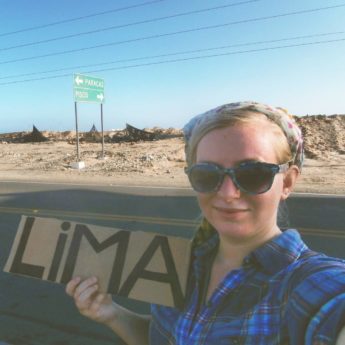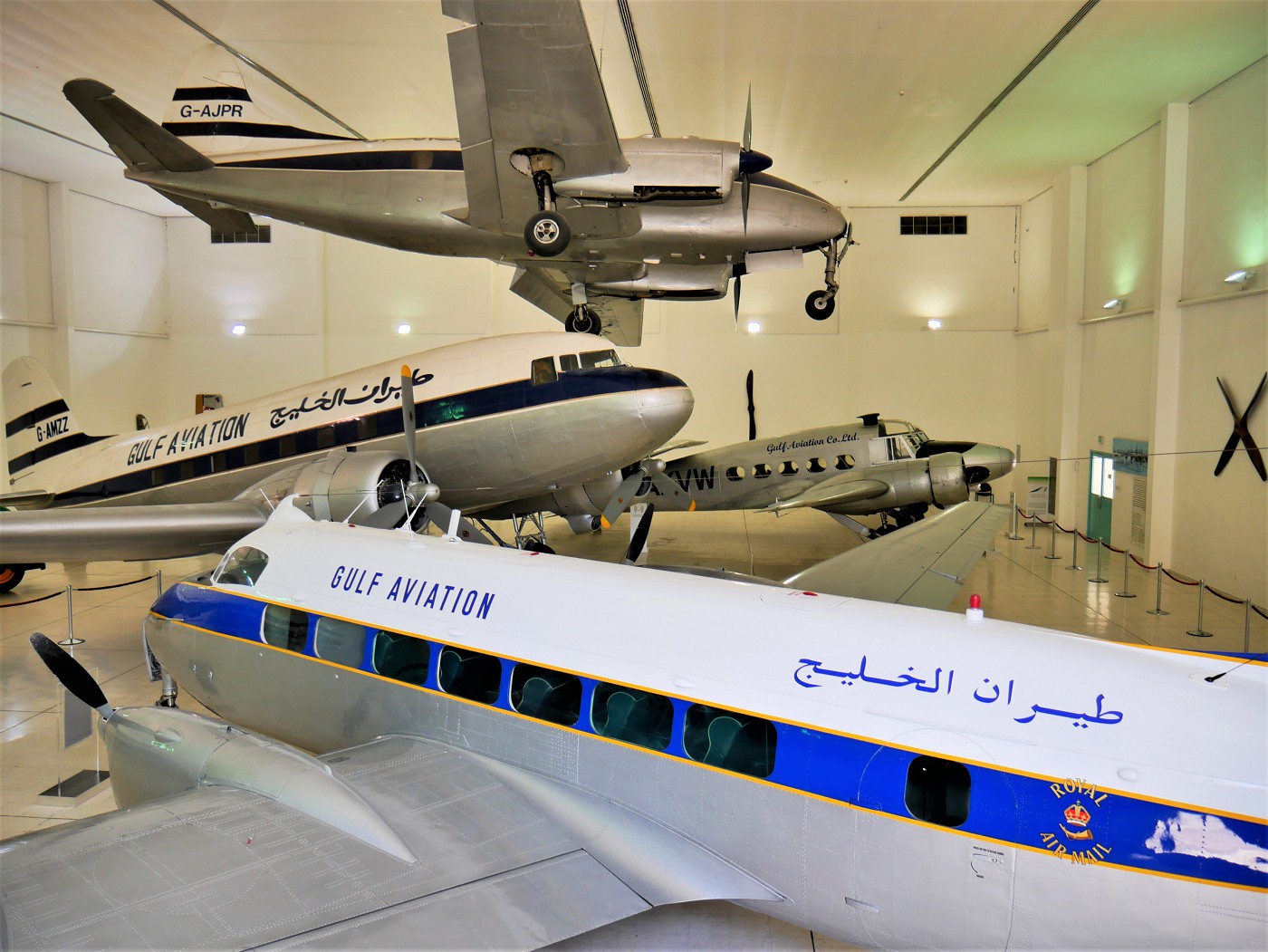
These events happened on the 5th and 21st of November 2021. Jonas and I visited the Ayasofya (aka Hagia Sophia) on a rather spontaneous basis. This was my second visit to the Ayasofya and my first visit since it became a mosque in July 2020. Click here to read about my Istanbul and Hagia Sophia experiences from March/April 2013. There’s also a breakdown of Hagia Sophia as a ‘wonder’ in the videogame Age of Empires II down below.
Contents
A Change of Plans
We arrived at the İDO pier at the indicated time of 9:30. During the downhill walk from our home in Kadıköy, we had already noticed the very dense fog. And it got denser and denser as we walked down. Walking past all the other piers to the İDO pier, we noticed something was off. Only when we spoke to a guy outside the İDO pier, we realized that the fog is too dense for any of the ferries to operate today. Our trip to Democracy and Freedom Island? Canceled. Fuuuuuck.
Our backpack was packed for a long day trip. We even had bought some simit and sandwiches just before arriving at the pier. What do we do now?
I suggested to Jonas that we’d visit the Hagia Sophia – or Ayasofya in Turkish – today. It would just be a metro trip from Kadıköy to the Marmaray station, followed by a short Marmaray ride under the Bosporus, and then a walk from Sirkeci station to the Ayasofya. Not a bad plan for a foggy day. Perhaps the museum-recently-turned-mosque will have an allure of mystery in the dense sea fog? We’ll see.
The best thing about visiting the Ayasofya at this morning hour was that we could visit between prayer times. Prayer times weren’t a concern during my first visit to the Ayasofya, since back then it was in use as a museum.
Our Experience Visiting the Ayasofya as a Mosque in 2021
November 5th, 2021
Can non-Muslims still enter the Hagia Sophia/Ayasofya now that it’s a Mosque?
A few days prior, I Googled hard if it would even still be possible to visit the Ayasofya in 2021. There were two concerns: covid-19 and if they let in non-Muslims now that it is a mosque. Covid-19 wasn’t the obstacle as most businesses and sights operate as usual. But I had to Google hard to find out whether we could still enter without being a member of Islam.
Eventually, I found a few sources that said non-Muslims can enter the Holy Hagia Sophia Grand Mosque (Ayasofya-i Kebir Cami-i Şerifi), but of course everyone has to dress modestly and women have to wear a hijab. And there’s carpet inside now, so shoes off!
Foggy Day at the Ayasofya
Once we arrived at Sirkeci station, we walked to the Ayasofya. The mosque was indeed shrouded in fog. Since there are many movable fences around and some serious security, it’s a little tricky to find the entrance to the grounds between the Ayasofya and the Blue Mosque. To my surprise, there wasn’t a bag check or a metal detector.

At 10:30, the queue to enter the Ayasofya was not that long and it moved very fast. I turned my buff and scarf into a hijab and I was ready. There were also scarf vendors around and a scarf borrowing point. Again, there was no real security at the entrance, which was surprising. And since it’s not a museum anymore, there was no need to buy tickets worth ₺100 to enter and it isn’t closed on Mondays anymore. I’d say that free entry and open daily is definitely an improvement!
The mass of masked people we were in slowly moved into the Ayasofya, stopping at regular intervals to take photos. There were the Christ icons and other mosaics that drew attention. Many women were still dicking around with their scarves since it’s a little tricky to also wear a face mask with your hijab if you’re not used to it by now. I didn’t see employees comment on the few men in shorts or the women in beanies.

![]()
Comparison of Ayasofya in 2021 and 2013
We arrived at the carpet zone and this was complete mayhem. People struggled to get their shoes on and off, to find a numbered box for their shoes, and how to put them back on after their visit. To my pleasant surprise, there were shoehorns available at regular intervals—which is something anyone from the former USSR appreciates.
We found a box for our shoes and entered the emerald green carpet. Once we were inside the main hall, it was… familiar? There wasn’t really a noticeable difference to the Ayasofya to my last visit, except that there was no ongoing renovation and they rolled out the carpet. It was much busier than in 2013 and yes, people wore more clothes on average. You can see (crappy) pictures of the Hagia Sophia in 2013 when it was a museum here:

I only realized there was a cat here when going through my pictures
I told Jonas it wasn’t much different from eight years ago. And it wouldn’t surprise me if they already had this gigantic carpet somewhere in storage for special events. So the whole process of ‘converting’ the Hagia Sophia Museum into the Ayasofya Mosque just involved rolling out a carpet and putting an Imam on payroll. And since non-Muslims are still allowed to enter, I think the controversy surrounding this conversion is completely overblown. A perfect example of fake outrage.

Because let’s face it: secularism is dead and has been for a long time.
If individual Christians want to pray inside the Hagia Sophia, I’d say it’s easier now that there’s carpet than before when it was a cold marble floor with no possibility to sit down. As far as I know, there are no specific Christian prayer times, so they can just kneel down and pray outside of Muslim prayer times. No one will stop you.
And I seriously doubt that the conversion of this monument from museum to mosque can destabilize the entire region. That truly does sound overdramatic.

Why is it so crowded though?
Despite our visit generally being very nice, it was so busy. Turkey has been one of two countries off the top of my head that has stayed open for tourism during the entire pandemic. Perhaps that reputation has funneled all the tourists into this one city in Europe?


At the front of the Ayasofya, there’s a big area cordoned off only for Muslims. From there, you can see the shiny mihrab and the minbar. The Christian icons in the same direction as the qibla are indeed half-covered with cloths to prevent praying to anything besides God. And though there’s a request to not photograph people while they’re praying, it’s an impossible task.
![]()

To the left of there, I see a white (Van) cat behind the off-limits area. I try very hard to pspspsps it towards me. But the all-white cat just notices me and decides to stay in the area without the tourists. Smart kitty.


View this post on Instagram
We shuffle around the carpet and spot the men’s prayer area in the right wing of the building and the women’s prayer area in the left wing. The little pavilion structure added in 1991 next to the omphalion was the only (Muslim) prayer area before it became a mosque again in 2020. And yes, the piece of floor that they decided to keep carpet-free is the omphalion. Apparently, they do cover more of the Christian icons during prayer times with cloths. Though the meaning of the omphalion isn’t clear, I wonder if there’s also a piece of carpet that exactly matches that spot to cover it up for prayer times?


I thought I hadn’t visited the upper galleries of the Hagia Sophia Museum back in 2013. So I thought perhaps we’d still try to do that as it sounds like a good way to escape the crowds. But when I Googled it, it appears you can only do this with a tour. It’s a little late for that.

![]()
We make our way out of the Ayasofya, find our shoes and use the shoehorn to put them on and walk out via the exit. It’s a different door than the entrance and at first we’re a little disoriented.


Over the next half hour, we circumambulate the building and meet many photogenic cats and one illegally cute kitten that steals our hearts.


I take more photographs of the exterior, but the fog is still so dense that I think it’s best if we return here on a sunny day. I spot one rooftop terrace a few hundred meters away that I think would be suitable for that.


Once we’re back at the entrance of Ayasofya, the queue to enter is very long and guides are hustling hard for our cash. It’s kind of funny that all of them approach us in Russian.

We visit the plaza between the Ayasofya and the Sultan Ahmed Mosque (aka Blue Mosque). It’s clearing up a little bit. Once we sit down on a bench, the afternoon (Zuhr) call to prayer begins. And sitting in between these two mosques, it’s kind of marvelous that there’s a call back and forth between the muezzin of the Sultan Ahmed and Ayasofya mosques that’s perfectly timed.


Finding The Best Ayasofya Viewpoint
21st of November, 2021
The reason we returned to the Ayasofya in the span of a month was… this article. I needed a good photo for this piece that best mimics the dimetric projection of the Age of Empires II game. In other words: I needed a photo on a sunny day of the whole building with an angle focused on one of the corners, preferably from a high viewpoint. During our foggy day visit, we’d spotted a business called Seven Hills Restaurant that had a roof terrace overlooking the Ayasofya and Blue Mosque from that angle. All we had to do was visit and drink tea or eat something.
When we arrived at the entrance, there were some employees encouraging people to enter. There was a small queue of people waiting for the elevator to the roof terrace and we joined them. From there, we still had to walk one floor up—so this is not a wheelchair-friendly viewpoint. And on the roof terrace, it was absolute mayhem.
Management had cordoned off a special zone of the roof terrace for taking photos and feeding the seagulls. Yes, there were actual plates of leftover fries from guests with forks for people to feed the birds. I first wanted to take photos before we’d sit down for tea, but nobody really seemed to care if we’d buy anything. There was also no photography fee for rooftop access without consumption despite the amazing angle.



We spent a good twenty minutes up there looking for the perfect photos with and without birds. We saw that almost everyone wanted a photo of themselves with the Ayasofya/Blue Mosque in the background and a seagull snatching a crusty fry off a plastic fork. Has feeding seagulls always been a thing in Istanbul, or has Feeding Steven gone mainstream?

In the end, I did get my desired pictures of the Ayasofya mosque before the crowdedness on this rooftop started to get to me. I went to the old spot next to Ayasofya to revisit the cow cats. Then was time to leave and eat some Malaysian food at Nur Muhammad Lokantasi before taking the tram back to Beyoğlu.


Representation of the Hagia Sophia Church Wonder in Age of Empires II
The Hagia Sophia is the textbook definition of a Wonder; it was the largest cathedral in the world for nearly a thousand years (537–1520). Its architects employed completely new techniques to build bigger and more impressively than ever before. The Hagia Sophia is so grand and representative of Byzantine architecture that even the Byzantines didn’t try to do it again elsewhere. Truly iconic.
Originally, it had a white marble exterior that would have shimmered from afar. The Hagia Sophia in Age of Empires II (AoE2) doesn’t feature any white marble exterior, but rather the yellow paint it might have once had. The dome in the game is more like the first dome before collapsing after an earthquake. There are some other major differences in the design in the game and the versions of Hagia Sophia before mosqueification; the game version has an octagonal plan for the dome support while the real-life version is circular.
Hover over this picture with your mouse on computer or tap and hold on phone to see the comparison.
Both in real life and in AoE2, the Hagia Sophia represents the Byzantine civilization (395 – 1453). The Byzantine Empire (aka Eastern Roman Empire) began when the Roman Empire split between west and east in 395. It ended with the Fall of Constantinople at the hands of the Ottomans in 1453 on a Tuesday. Later that week, Sultan Mehmet II performed the Friday Prayers in Hagia Sophia and thereby converting it to a mosque for the first time.
During its Byzantine era, the site hosted two preceding churches also by the name of Hagia Sophia from 360 till 532, of which the last one burned to the ground during riots under the rule of Emperor Justinian I. A few weeks later, that same emperor decided to build the Hagia Sophia sort of as we know it today. It took them five years and 10 months to complete the structure. It feels almost suspicious how there was a riot and then bam! the plans for a new church were already there. It’s almost as if someone wanted the space cleared…
It was the most important seat of Eastern Christianity and later the Eastern Orthodox Church during the Byzantine era. As the Byzantine Empire was a theocracy, the church cathedral had not only religious but also political functions. The Byzantines first spoke Latin, but after the 7th century, they favored Greek. In AoE2, the in-game language is Latin.
In AoE2, the Byzantines are a defensive civilization. They appear in a large number of campaigns, but you can only play as the Byzantines in the Bari campaign. It makes sense that the Byzantines are defensive because Constantinople had strong walls that often successfully thwarted sieges. The many campaign appearances also make sense because the Byzantine Empire was sizeable and bordered many other civilizations during a long period of time. It doesn’t help that every time the Latin Church organized a crusade, they passed through Constantinople to stir up some shit.
Interesting stuff? Consider buying me a sahlep!

































